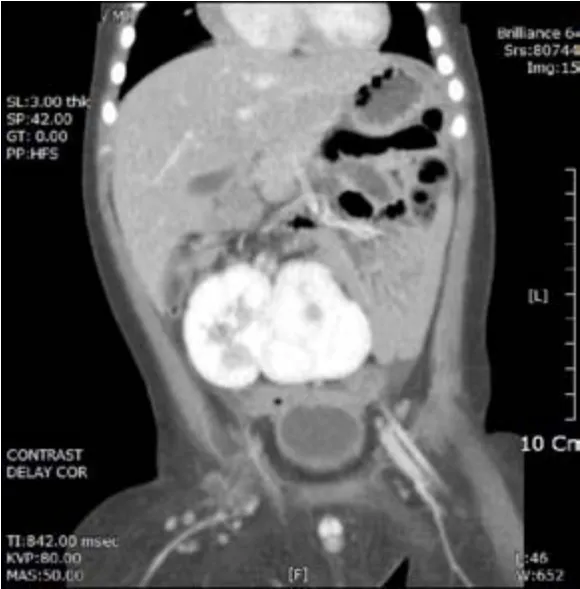Lump type crossed fused renal ectopia with bilateral vesicoureteral reflux:A case report
2019-04-17TaesooChoiKooHanYooRanSongDongGiLee
Taesoo Choi,Koo Han Yoo,Ran Song,Dong-Gi Lee
Abstract
Key words: Kidney;Congenital abnormalities;Vesicoureteral reflux;Ureteroneocystostomy;Politano-Leadbetter;Case report
INTRODUCTION
Crossed fused renal ectopia is a rare anomaly characterized by the ectopic kidney crossing the midline with the ureter at the ureterovesical junction (UVJ) in the orthotopic position.Vesicoureteral reflux (VUR) is a relatively common urologic disorder,and is traditionally categorized as primary or secondary according to its etiology.VUR is no longer thought to be a disease in itself;it is now considered a marker of heterogeneous conditions of the entire urinary tract,including congenital renal hypoplasia and dysplasia,primary reflux caused by an incompetent UVJ,altered lower urinary tract function,and inherent predisposition to urinary tract infection (UTI).It poses many challenges to the urologist for diagnosis and treatment.
Generally,renal fusion anomalies are classified into two groups:horseshoe kidney and crossed fused ectopia.Crossed fused ectopic kidney is a rare anomaly of the ascent of the kidney,which can be associated with VUR,but has not been reported widely.
We report our experience with a male neonate who suffered from recurrent UTI due to crossed fused renal ectopia,accompanied by bilateral VUR.
CASE PRESENTATION
Chief complaints
A 1-mo-old male child was referred to the department of urology for evaluation and management of abnormal prenatal ultrasonography (US) findings.
History of present illness
Prenatal US had shown an empty renal fossa,and a pelvic kidney suggestive of renal ectopia with agenesis had been observed.
History of past illness
The patient’s gestational period was 38 + 2 wk,with birth weight 2520 g,and perinatal abnormalities such as meconium staining or premature rupture of membranes were not present.There was not any significant risk factor or family history.
Physical examination
Physical examination was unremarkable.
Laboratory examinations
Urinalysis demonstrated significant pyuria.
Imaging examinations
Technetium-99m dimercaptosuccinic acid (DMSA) scan demonstrated sufficient uptake indicating a single ectopic right kidney with normal function,with left renal agenesis,which was consistent with the US findings.Voiding cystourethrogram(VCUG) was performed for possible associated VUR,and showed 2 dilated ureters with VUR (right:grade IV,left:grade IV) leading out from a fused kidney situated at the right side of the lower abdomen.
A second breakthrough infection occurred at 9 mo of age and abdominal contrast computed tomography (CT) was performed for further evaluation.It showed the left kidney crossing the midline to fuse to the right kidney situated in the right abdomen,from the aortic bifurcation to the iliac crest.Both renal hila faced to the front,indicative of an associated rotational anomaly.The right kidney was supplied by the right renal artery and a branch of the left common iliac artery,while the left kidney was fed by only the left renal artery.Pyelonephritis that had not been observed previously was noted (Figures 1 and 2).
FINAL DIAGNOSIS
We diagnosed crossed fused renal ectopia (“lump” type) with associated bilateral VUR.
TREATMENT
Initially,continuous low-dose antibiotic prophylaxis was started.Despite antibiotic prophylaxis,he was readmitted through the emergency room 3 months later because of a febrile UTI.
In order to prevent these repeated events of infection,we decided to perform a bilateral ureteroneocystostomy to manage VUR.During the operation,we observed both ureters to be very short,particularly on the left side,as expected preoperatively.The length of the ureters was insufficient,and therefore the Politano-Leadbetter technique was carried out instead of the Cohen procedure.
OUTCOME AND FOLLOW-UP
There was no significant postoperative complication and the patient was discharged after a week.No abnormal findings were reported on VCUG three months after surgery,and the patient had no febrile UTI or other complications during the followup period of six years.As a biennial routine follow-up,serum creatinine was 0.78 mg/dL and US showed no evidence of hydronephrosis.
DISCUSSION
Crossed fused renal ectopia is a rare congenital abnormality of the urinary tract.It is the second most common fusion anomaly,with an incidence placed at 1 in 2000 autopsies,with male predominance (3:2)[1].About 2% of the anomalies are complete crossed fused ectopia,with either lump or disc kidneys.The ectopic kidney crosses the midline to lie on the opposite side from its ureteral insertion into the bladder.Most cases of crossed renal ectopia are discovered incidentally,often by antenatal sonography when two kidneys are not identified.US evaluation of the newborn infant may underestimate the hydronephrosis and dilated ureter,due to physiologic dehydration[2].The typical US findings in crossed fused renal ectopia include an anterior/posterior notch with distinguishable orientation of the collecting systems in the kidneys.In addition,US can provide important information on the presence of abnormal vasculature,hydronephrosis,or urolithiasis.CT is also useful to demonstrate the precise anatomy and provide functional information about such anomalies.A DMSA radionuclide scan is used in evaluating renal morphology and structure.
Patients may remain asymptomatic throughout life,but symptoms may occur due to minor trauma associated with the abnormal location.They may have abdominal or flank pain,a palpable mass,or dysuria.When symptoms do occur,they are often related to infection,obstruction,or urolithiasis.One previous study reported that about one-third of patients had a history of pyelonephritis and one-quarter had hydronephrosis[3].The life-long clinical course in the aspect of renal function is still remained unclear.
There are six different varieties of crossed ectopia with fusion.The most common form is unilateral fused type with inferior ectopia,in which the upper pole of the crossed kidney is fused to the lower pole of the normally positioned kidney.The second most common type is the sigmoid,or S-shaped,kidney.The crossed kidney is inferior,but the two renal pelvises face in opposite directions.The lump,or “cake,”kidney and the “disc” kidney both involve extensive fusion of the two renal masses.With an L-shaped kidney,the crossed kidney assumes a transverse position.With a superior ectopic kidney,the least common type is the crossed ectopic kidney,which lies superior to the normal kidney.Among these,only the unilateral lump kidney and disc kidney are completely fused.In our case,the fusion corresponded to the lump type crossed fused ectopic kidney.Pannorlus first described this condition as an extreme variant of horseshoe kidney in 1654[4].

Figure1 Enhanced computed tomography showing right crossed fused renal ectopia located in the pelvis.
It has been suggested that there is a significant correlation between genitourinary abnormalities and malformations such as musculoskeletal,gastrointestinal,and cardiovascular anomalies[5].For this reason,early and complete evaluation is needed for the patient with crossed renal ectopia.
One of the most common associated abnormalities is VUR,which is frequently noted in the ectopic kidney.The rate of spontaneous resolution was about 35%-40% in one-year-old infants regardless of the VUR grades[6].Surgical correction can be considered in certain circumstances that patient has a history of febrile UTI,worsening hydronephrosis,abnormal kidney function on renal scan,or preference for surgical treatment.The predictive factors of surgery included older age at initial diagnosis,the presence of antenatal hydronephrosis,bilateral and high grade VUR in a large-scaled cohort study[7].Despite hopeful chance of spontaneous VUR resolution based on the previous studies,we predicted little chance of spontaneous resolution because of the complicated VUR with crossed fused kidney.And early surgical repair was considered and performed.Previous study demonstrated that VUR occurred in 20% of crossed renal ectopy,30% of simple renal ectopy,and 70% of bilateral simple renal ectopy cases[8].Less common problems include ureteropelvic junction obstruction,renal dysplasia,and renal tumors.
In our case,the Politano-Leadbetter technique was used to correct VUR instead of the Cohen procedure,due to the short ureters.In the Politano-Leadbetter technique,we create a long tunnel and perform retrograde catheterizationviaan intact ureteral orifice.However,making a new cephalad hiatus is challenging for the operating surgeon.The Paquin technique is another common option for the management of similar cases.It has an advantage over the Politano-Leadbetter technique because it is performed under direct vision,thus reducing the risk of peritoneal injury.
CONCLUSION
Crossed fused renal ectopia is often misdiagnosed as a solitary kidney.As suggested above,urologists should be aware of such anomalies.The length of the ureter of the ectopic kidney is usually shorter than normal,and that kidney appears to sustain more pressure with VUR compared with the normal state;this causes renal damage more easily.Early diagnosis and proper management of renal ectopia with VUR are necessary.During surgery,the Politano-Leadbetter or Paquin technique may be preferred if there is insufficient length of the ureters.

Figure2 The comparison between preoperative voiding cystourethrogram (A) and 3-mo postoperative voiding cystourethrogram (B).
杂志排行
World Journal of Clinical Cases的其它文章
- Effects of apoptosis on liver aging
- Liver involvement in the drug reaction,eosinophilia,and systemic symptoms syndrome
- Surgical method choice and coincidence rate of pathological diagnoses in transduodenal ampullectomy:A retrospective case series study and review of the literature
- lndividualized minimally invasive treatment for adult testicular hydrocele:A pilot study
- Successful totally transthoracic echocardiography guided transcatheter device closure of atrial septal defect in pregnant women
- Cardiac amyloidosis:A case report and review of literature
